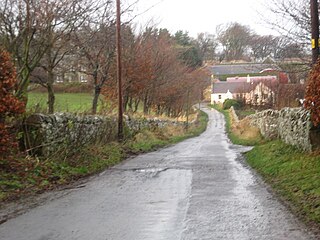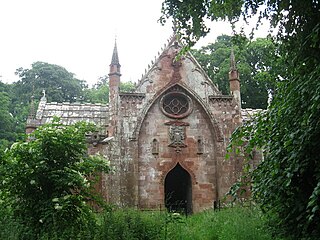Related Research Articles

William de Warenne, 2nd Earl of Surrey was the son of William de Warenne, 1st Earl of Surrey and his first wife Gundred. He was more often referred to as Earl Warenne or Earl of Warenne than as Earl of Surrey.
Patrick IV, 8th Earl of Dunbar and Earl of March, sometimes called Patrick de Dunbar "8th" Earl of March, was the most important magnate in the border regions of Scotland. He was one of the Competitors for the Crown of Scotland.

Walter Stewart was the 6th Hereditary High Steward of Scotland and was the father of King Robert II of Scotland, the first Stewart monarch.
Sir Robert Lauder of the Bass was a Scottish knight, armiger, and Governor of the Castle at Berwick-upon-Tweed. He was also a member of the old Scottish Parliament. The Lauders held the feudal barony of The Bass, East Lothian, Edrington Castle and lands in the parish of Mordington, Berwickshire, Tyninghame in Haddingtonshire, and numerous other estates and properties elsewhere in Scotland.

Bara, anciently spelt Baro, is an agricultural parish in East Lothian, Scotland, which adjoins the parish of Garvald to the east, and Lauder across the Lammermuir Hills. It is south-west of Haddington.
Elizabeth of Vermandois, was a French noblewoman, who by her two marriages was the mother of the 1st Earl of Worcester, the 2nd Earl of Leicester, the 3rd Earl of Surrey, and of Gundred de Warenne, mother of the 4th Earl of Warwick.

Gifford is a village in the parish of Yester in East Lothian, Scotland. It lies approximately 4 miles (6.4 km) south of Haddington and 25 miles (40 km) east of Edinburgh.
The Justiciar of Lothian was an important legal office in the High Medieval Kingdom of Scotland.

Yester Castle is a ruined castle, located 1+1⁄2 miles southeast of the village of Gifford in East Lothian, Scotland. The only remaining complete structure is the subterranean Goblin Ha' or Hobgoblin Ha' . It is a Scheduled Ancient Monument, recorded as such by the Royal Commission on the Ancient and Historical Monuments of Scotland.
Holders of the office of Lord Chamberlain of Scotland are known from about 1124. It was ranked by King Malcolm as the third great Officer of State, called Camerarius Domini Regis, and had a salary of £200 per annum allotted to him. He anciently collected the revenues of the Crown, at least before Scotland had a Treasurer, of which office there is no vestige until the restoration of King James I when he disbursed the money necessary for the maintenance of the King's Household.
Gospatric II was Earl of Lothian or Earl of Dunbar in the early 12th century.
Gospatric III or Cospatric III was a twelfth-century Anglo-Celtic noble, who was Earl of Lothian and later the Earl of Dunbar, and feudal Lord of Beanley.
Hugh de Morville of Appleby in Westmorland, England, hereditary Constable of Scotland, was a Norman knight who made his fortune in the service of David FitzMalcolm (d.1153), Prince of the Cumbrians, later King of Scotland.
Patrick I, Earl of Dunbar and lord of Beanley, was a 13th-century Anglo-Scottish noble.
The Broun Baronets are a branch of the ancient Broun of Colstoun family whose estate near Haddington, East Lothian, remains to this day in the possession of a cadet family.

Sir Robert de Lawedre (Lauder), Knt., of Quarrelwood, Edrington, and the Bass was Justiciar of Scotia, a Scottish soldier of great prominence and Captain of Urquhart Castle. He is recorded by Fordun, in his Scotichronicon, and in Extracta ex variis Cronicis Scocie as "Robertus de Lavedir 'the good'"
Ada de Warenne was the Anglo-Norman wife of Henry of Scotland, Earl of Northumbria and Earl of Huntingdon. She was the daughter of William de Warenne, 2nd Earl of Surrey by Elizabeth of Vermandois, and a great-granddaughter of Henry I of France. She was the mother of Malcolm IV and William I of Scotland.

Giffordland is in North Ayrshire, Parish of Dalry (Cunninghame) in the former Region of Strathclyde, Scotland.

Yester Chapel is situated on the estate of Yester House, at the south-east edge of the village of Gifford in East Lothian, Scotland. The chapel is situated at grid reference NT544671. It is a Category A listed building.
Reginald de Warenne was an Anglo-Norman nobleman and royal official. The third son of an earl, Reginald began his career as an administrator of his brother's estates and continued to manage them for his brother's successor, William, the second son of King Stephen. Reginald was involved in the process that led to the peaceful ascension of Henry fitzEmpress to the throne of England in 1154 and served the new king as a royal justice afterwards. He played a minor role in the Becket controversy in 1170, as a member of the party that met Becket on his return to England from exile in 1170.
References
- History of the Commoners of Great Britain and Ireland etc., by John Burke, London, 1836, vol. 3, pps: 434–5.
- The Scottish Nation by William Anderson, Edinburgh, 1867, vol.V, pps: 297–8.
- Fourteen Parishes of the County of Haddington, by John Martine, Edinburgh, 1890, pps: 292–5.
- The Normans in Scotland, by R.L.Graeme Ritchie, Edinburgh University Press, 1954, p. 276.
- The Buildings of Scotland – Lothian (except Edinburgh), by Colin McWilliam, Penguin Books Ltd., London, 1978, pps:208-215. ISBN 0-14-071066-3
- The Anglo-Norman Era in Scottish History, by Professor G.W.S.Barrow, Clarendon Press, Oxford, 1980, p. 43. ISBN 0-19-822473-7
- The Origin of the Gifford Family in Scotland by G.Charles-Edwards, in The Scottish Genealogist, vol.XXVII No.4, Edinburgh, December 1980, pps: 152–161. ISSN 0300-337X